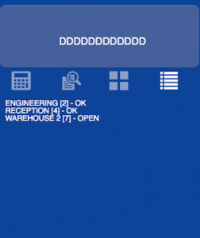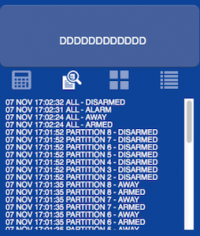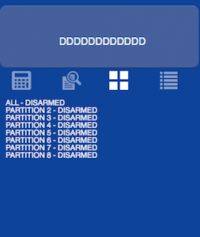Bentel
The Bentel KYO320 is an advanced, multi-area security system integrated HSYCO.
The KYO320 driver in HSYCO supports the integration of more than one KYO320 unit on the same HSYCO SERVER.
The integration with HSYCO can be accomplished through the standard RS-232 port on the KYO320’s motherboard.
Contents
Communication
Employ a DE-9 (often called DB-9) female-female RS-232 crossed cable to connect the RS-232 KYO port to the serial port on HSYCO SERVER. The cable must follow this pinout diagram:
2 ↔ 3 3 ↔ 2 5 ↔ 5
RS-232 parameters:
| Baud rate | same as defined on the KYO320 (usually 9600, 38400 or 57600) |
| Data bits | 8 |
| Stop bit | 1 |
| Parity | even |
| Flow control | none |
HSYCO Configuration
Options
| ID | Default | Values | Description |
|---|---|---|---|
| gui | true | true | enable support for the UI object, UISET actions and USER commands |
| false | disable UI support | ||
| language | system language | en | language of log and display messages. Supported values are it and en |
| it | |||
| zoneactivitylog | false | true | logs the open/close status of zones in the log page and security.log files |
| false | disable zone status log | ||
| code |
|
the user code to be used when sending IO commands to the KYO, if code is not explicitly set in the command | |
| logsize | 50 | n ≥ 0 | the number of log lines to display in the UI object |
| polltime | 1000 | n ≥ 0 | the data polling interval, in milliseconds. Shorter time improve the response of the system, but increase the load on the CPU of both HSYCO and the KYO system |
bentel.ini
The bentel.ini file is an optional configuration file located in the main directory (same directory as hsyco.ini or hsyco.jar) and used to define zones and partitions names. If defined, these names will be used instead of the original numbers in the log files and the bentel GUI object.
The bentel.ini is automatically detected at start-up. Changes to this file become effective when the I/O Server is restarted.
For each zone or partition, enter a line formatted as:
<io_server_id>.zone.<n> = <name> <io_server_id>.area.<n> = <name>
For instance:
kyo.zone.1 = kitchen kyo.zone.2 = garage kyo.area.1 = basement kyo.area.2 = second floor
Datapoints
| ID | Value | R/W | Description |
|---|---|---|---|
| connection | online | R | connection established |
| offline | R | HSYCO can't connect to the panel | |
| system.fault | 1 | R | general system fault |
| 0 | R | reset | |
| system.batteryfault | 1 | R | general battery fault |
| 0 | R | reset | |
| system.lowbattery | 1 | R | low battery |
| 0 | R | reset | |
| system.nobattery | 1 | R | low battery |
| 0 | R | reset | |
| system.nopower | 1 | R | general no AC power fault |
| 0 | R | reset | |
| system.tamper | 1 | R | general tamper condition (central unit, zones, modules) |
| 0 | R | reset | |
| system.radiofault | 1 | R | general radio modules fault |
| 0 | R | reset | |
| system.radiolowbattery | 1 | R | radio modules low battery |
| 0 | R | reset | |
| system.duress | 1 | R | duress status |
| 0 | R | reset | |
| system.maintenance | 1 | R | maintenance mode |
| 0 | R | reset | |
| zone.<n>.disabled | 1 | R | zone <n> disabled |
| 0 | R | zone <n> enabled | |
| zone.<n>.alarm | 1 | R | zone <n> alarm |
| 0 | R | reset | |
| zone.<n>.tamper | 1 | R | zone <n> tamper alarm |
| 0 | R | reset | |
| zone.<n> | enable | W | enable zone <n> using default code |
| disable | W | disable zone <n> using default code | |
| enable.<c> | W | enable zone <n> using code <c> | |
| disable.<c> | W | disable zone <n> using code <c> | |
| partition.<n>.armed | 1 | R | area <n> is armed (any mode) |
| 0 | R | reset | |
| partition.<n>.disarmed | 1 | R | area <n> is not armed |
| 0 | R | reset | |
| partition.<n>.away | 1 | R | area <n> away mode |
| 0 | R | reset | |
| partition.<n>.stay | 1 | R | area <n> stay mode |
| 0 | R | reset | |
| partition.<n>.staynodelay | 1 | R | area <n> stay no delay mode |
| 0 | R | reset | |
| partition.<n>.alarm | 1 | R | area <n> alarm memory |
| 0 | R | reset | |
| partition.<n> | away | W | arm area <n> using default code |
| disarm | W | disarm area <n> using default code | |
| stay | W | stay arm area <n> using default code | |
| staynodelay | W | instant stay arm area <n> using default code | |
| away.<c> | W | arm area <n> using code <c> | |
| disarm.<c> | W | disarm area <n> using code <c> | |
| stay.<c> | W | stay arm area <n> using code <c> | |
| staynodelay.<c> | W | instant stay arm area <n> using code <c> | |
| out.<n> | off | W | turn off output <n> using default code |
| on | W | turn on output <n> using default code | |
| off.<c> | W | turn off output <n> using code <c> | |
| on.<c> | W | turn on output <n> using code <c> |
User Interface
Bentel Object
The user interface for the Bentel KYO320 multi-area intrusion detection system:
The Bentel object is listed in the Project Editor’s new object list only when at least one Bentel I/O Server is defined.
Parameters
- server id: the server ID
- position: the object's position. Use the pixels or rows and columns coordinates format
Syntax
(bentel <server id>; <position>)
E.g.
(bentel serverid; x10y20)
UISET Actions
You can use any object that accepts a text attribute, usually text, but also marquee and others, to display the status of the system according to the following table:
| ID | Attribute | Set to | |
|---|---|---|---|
| areas | value | the status of all partitions | |
| log0 | value | the latest entry of the security log for a short period | |
| logs | value | the latest entries of the security log (as many as specified in hsyco.ini) | |
| zones | value | the status of all known zones (zones are added to this list as soon as an event is detected on a zone) | |
| connection.label.online | visible | true when the panel is connected to HSYCO, false otherwise | |
| connection.label.offline | visible | true when the panel is not connected to HSYCO, false otherwise | |
| partition.<n>.label.alarm | visible | true when partition <n> alarm is active, false otherwise | |
| partition.<n>.label.armed | visible | true when partition <n> is armed, false otherwise | |
| partition.<n>.label.disarmed | visible | true when partition <n> is disarmed, false otherwise | |
| partition.<n>.label.away | visible | true when partition <n> is armed in away mode, false otherwise | |
| partition.<n>.label.stay | visible | true when partition <n> is armed in stay mode, false otherwise | |
| partition.<n>.label.staynodelay | visible | true when partition <n> is armed in stay no delay mode, false otherwise | |
| zone.<n>.label.alarm | visible | true when zone <n> alarm is active | |
| zone.<n>.label.tamper | visible | true when zone <n> tamper alarm is active | |
| zone.<n>.label.disabled | visible | true when zone <n> is disabled | |
Log Files
A permanent record of all the events shown in the log page is saved in a file called security.log in the logs/YYYY directory for the current year.
This file is never overwritten or deleted by HSYCO.
2014.07.30 20:09:21.760 - SECOND FLOOR - ARMED 2014.07.30 20:09:21.763 - SECOND FLOOR - AWAY 2014.07.30 20:10:02.364 - [2] GARAGE - OPEN 2014.07.30 20:10:04.779 - [2] GARAGE - OK 2014.07.30 20:10:06.167 - BASEMENT - ALARM 2014.07.30 20:10:48.477 - BASEMENT - DISARMED 2014.07.30 20:10:48.481 - SECOND FLOOR - DISARMED 2014.07.30 20:39:31.326 - ZONE 281 - OPEN 2014.07.30 20:39:36.708 - ZONE 281 - OK 2014.07.30 20:40:41.571 - AC POWER - FAULT 2014.07.30 20:49:58.945 - ZONE 281 - OPEN 2014.07.30 20:50:04.181 - ZONE 281 - OK 2014.07.30 20:50:11.559 - AC POWER - OK
Other information related to the Bentel KYO driver are saved in the daily message.log files.
Release Notes
3.3.0
- Bentel KYO driver converted to I/O Server
- Java API write command methods are now obsolete and deprecated, replaced by IO write commands
- new (bentel) object
2.0.0
- full integration within HSYCO 2.9.0
1.1.0
- change to the status polling thread to improve recovery time after transient communication problems
Bentel, KYO and KYO320 are registered trademarks of BENTEL SECURITY SRL.



